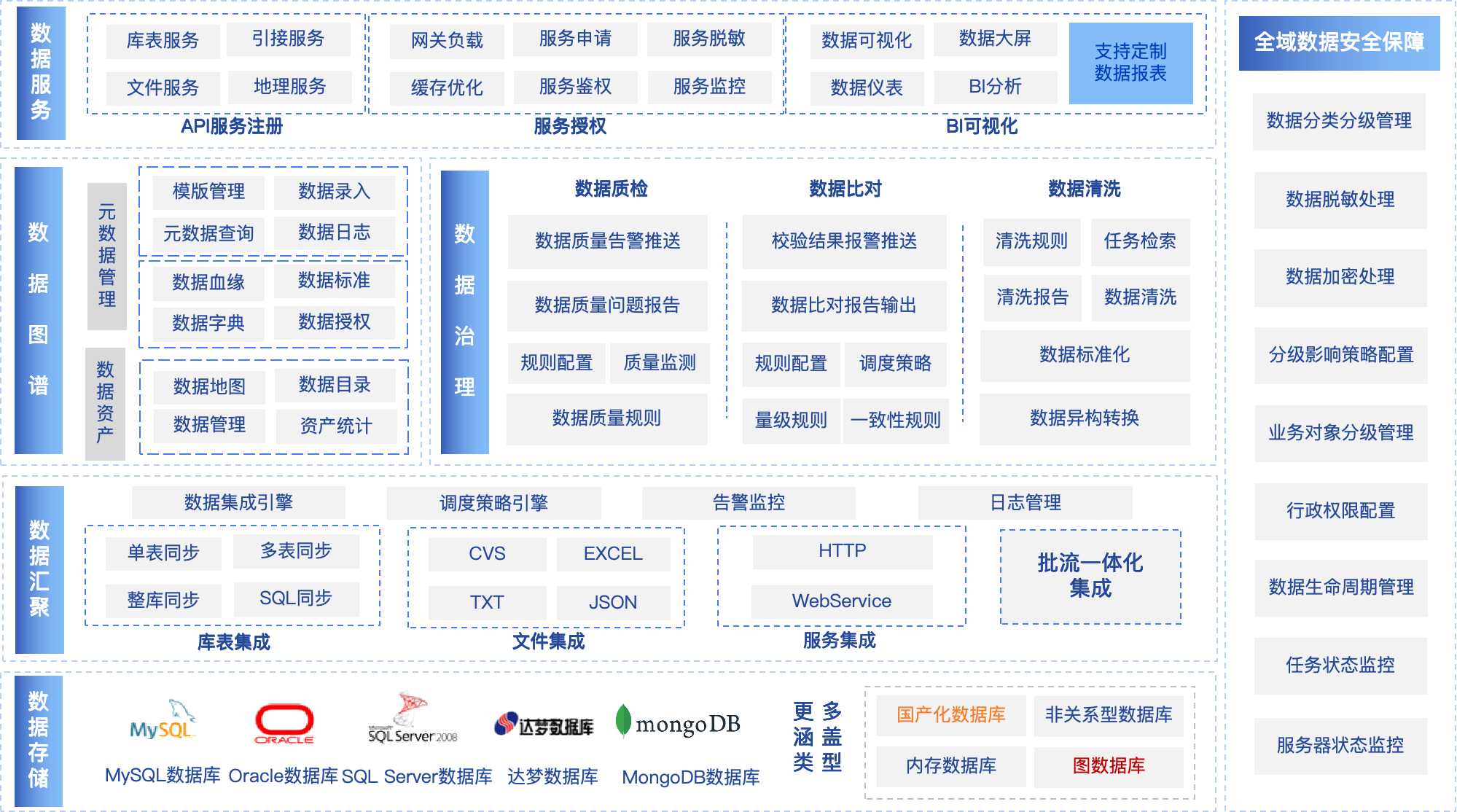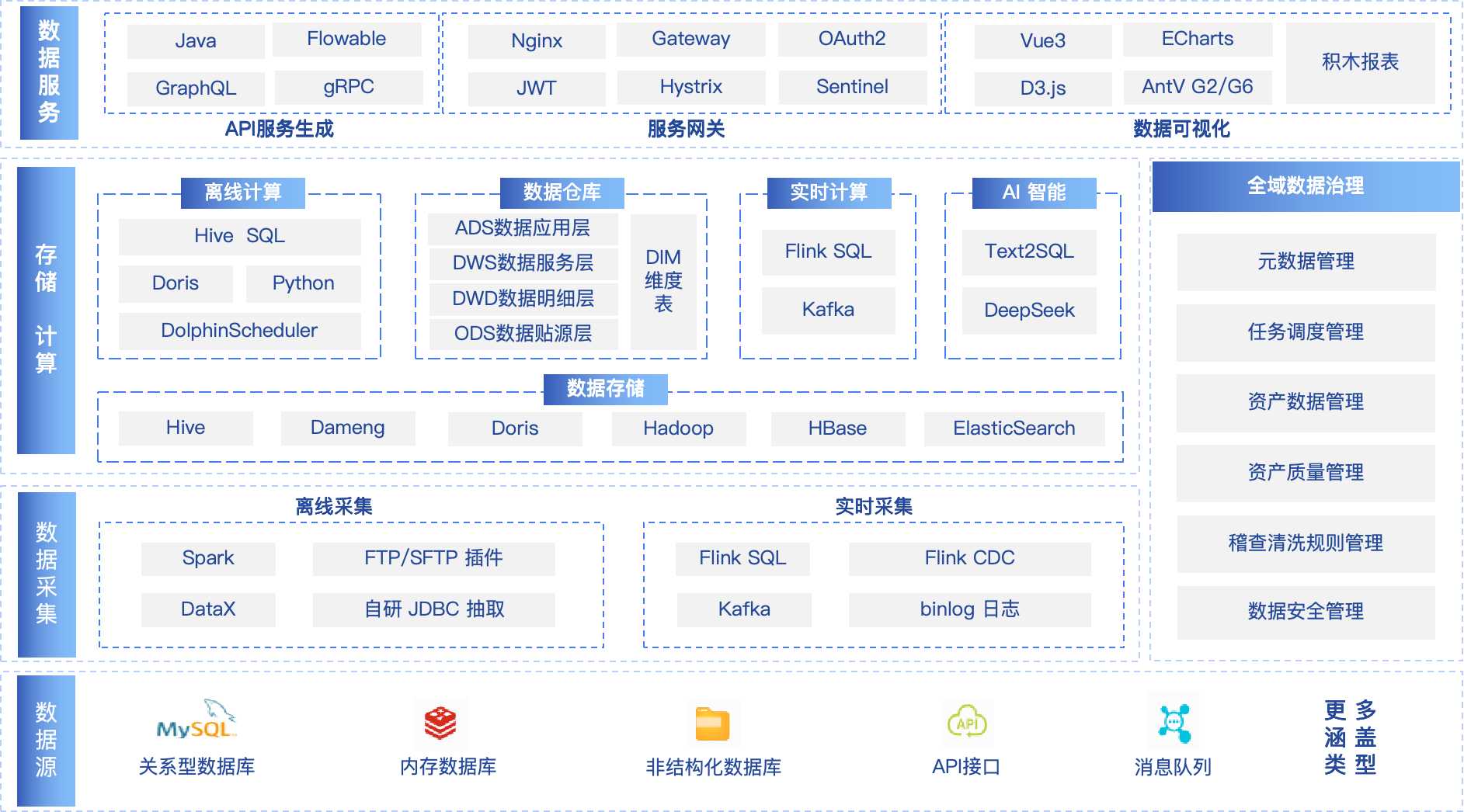Introduction

qData Data Platform is an enterprise-grade data management platform that integrates data integration, standard management, asset governance, quality control, service enablement, and intelligent analytics. It is designed to help organizations achieve unified management, efficient governance, and value realization of their data resources.
We follow the principles of efficiency, security, flexibility, and openness, continuously adopting cutting-edge technologies to make data the true driving force of enterprise growth.
qData is available in both Commercial Edition and Open-Source Edition, meeting the needs of users across different scales and scenarios.
- Commercial Edition: Full-featured, covering the entire lifecycle of system management, data ingestion, modeling, security, and services. Thoroughly polished and tested, it is designed for large-scale, complex scenarios with dedicated services and intelligent capabilities to ensure stable and efficient enterprise operations.
- Open-Source Edition: Focused on core features, including basic management, common data source integration, modeling, and quality checks. Lightweight, easy to use, and low-barrier, it is ideal for SMEs or individual developers to quickly practice and explore.
The two editions complement each other: the Commercial Edition acts like an expert consultant, providing depth and assurance; the Open-Source Edition acts like a mentor, helping you get started at low cost. Whichever you choose, qData will be a reliable partner to unlock data value and accelerate digital transformation.
✨✨✨ Open-Source Demo ✨✨✨ 👉 https://qdata-demo.qiantong.tech, Account: qData / Password: qData123
✨✨✨ Commercial Demo ✨✨✨ 👉 https://qdata-pro.qiantong.tech, For demo accounts, please contact us.
A little encouragement 🚀
If qData has been helpful to you, please give us a Star ⭐️ — it’s our greatest motivation to keep improving!
👉 [Star us on Gitee] | 👉 [Star us on GitHub]

Use Cases
qData is ideal for organizations seeking to integrate, govern, and analyze multi-source data, eliminate silos, improve quality and efficiency, and achieve data-driven business innovation.
| Scenario | Description | Typical Clients |
|---|---|---|
| Data Integration & Governance | Need to aggregate and centrally manage data from different systems, databases, and external partners. | Government agencies, large enterprises, research institutions |
| Quality & Efficiency Improvement | Struggling with poor data quality and inefficient processing that impacts analytics and applications. | Financial institutions, manufacturing firms, internet companies |
| Breaking Data Silos | Multiple independent systems operate in isolation, preventing data sharing and limiting collaboration. | Enterprise groups, public service organizations, smart city projects |
| Decision-Making & Innovation | Looking to leverage data analytics for strategic decision-making and business innovation. | Enterprise executives, product innovation teams, R&D institutes |
| Digital Transformation Support | Enterprises or governments planning or undergoing digital transformation. | Government departments, SOEs, growth-oriented SMEs |
Advantages
| Key Advantage | Description |
|---|---|
| Efficient Data Integration | Integration module comparable to Kettle, with strong compatibility and lower migration/usage costs. |
| End-to-End Lifecycle | Covers data acquisition, governance, modeling, and service sharing — supporting a full business loop. |
| Lightweight Deployment & Elastic Scaling | Monolithic architecture by default (easy to use); can switch to microservices for horizontal scalability. |
| High-Performance Processing | A single node can handle tens of millions of records per minute. |
| Unified Batch & Stream Processing | Supports both batch and stream data processing across multiple engines. |
| Comprehensive Asset Management | Unified management of structured and unstructured data, with clear asset visibility. |
| Data Quality & Compliance | Conforms to GB/T 36344 national standards, ensuring accuracy, consistency, and compliance. |
| Integrated Dev & Ops | Tasks can be reused across development, testing, and production environments, simplifying operations. |
| Open-Source Friendly | Out-of-the-box, quick to deploy, with demo guides and an active community. |
| Smooth Upgrade Path | Start with Open-Source Edition for exploration, then migrate seamlessly to Commercial Edition when needed. |
Core Features Overview
The platform adopts a modular design, covering 12 core functional modules. See the full list here: qData Features Overview
| No. | Module | Description |
|---|---|---|
| 1 | System Management | Platform-level operations & RBAC access control. Includes user, role, department, and position lifecycle management, menu config, dictionary, parameters, announcements, and operation logs. |
| 2 | Basic Management | Builds organizational frameworks and classification systems (e.g., assets, models, APIs, tasks) for standardized and searchable data organization. |
| 3 | Data Ingestion | Supports major relational databases (MySQL, Oracle, DM, etc.), big data platforms (Hive, Doris, ClickHouse), MQs (Kafka), and file systems (OSS, HDFS). |
| 4 | Data Standards | Logical modeling, metadata, dictionary tables, and model materialization. Supports reverse import from physical DBs into logical models. |
| 5 | Data Assets | Asset inventory and visualization with maps, discovery, lineage, and scheduling. Improves discoverability and trust. |
| 6 | Data Governance | ETL, real-time streaming (Flink), job orchestration, monitoring. Rich transformation components and cleaning rules. |
| 7 | Data Quality | Completeness, uniqueness, validity, consistency, timeliness checks. Quality task execution and issue remediation. |
| 8 | Data Security | Classification & grading, sensitive data recognition, access control, encryption, and dynamic masking. |
| 9 | Data Services | Standardized APIs with publishing, auth, rate limiting, blacklists, online testing, and call logs. |
| 10 | Data Resource Portal | User-facing entry with dashboards, catalogs, knowledge center, and service applications. |
| 11 | Data Visualization | Reports, dashboards, and BI screens with drag-and-drop editor, chart library, and drill-down. |
| 12 | AI Capabilities | Text2SQL for natural language to SQL. Planned ChatBI conversational analytics. |
Overall Architecture

Technology Stack
qData adopts a front-end/back-end decoupled architecture: backend powered by Spring Boot, frontend by Vue 3, plus popular middleware and data tools.
| Category | Technology | Description |
|---|---|---|
| Backend | Spring Boot | Rapid development, modularization, supports microservices. |
| Spring Security | Authentication & authorization. | |
| MySQL / PostgreSQL / DM / KingbaseES | Multiple mainstream databases. | |
| MyBatis-Plus | Simplifies DB operations, automated CRUD. | |
| Redis | High-performance caching, distributed locks, message queues. | |
| RabbitMQ | Asynchronous messaging, decoupling, reliable delivery. | |
| Frontend | Vue 3 | Modern reactive framework with component-based development. |
| Element UI | Rich UI components for consistent UX. | |
| Vite | Lightweight dev/build tool with fast HMR. | |
| 3rd-Party | DolphinScheduler | Visual workflow orchestration & scheduling. |
| Spark | Unified batch/stream distributed computing. | |
| Hive | Data warehouse with modeling and metadata. | |
| HBase | Large-scale semi/unstructured data storage & queries. |
Technical Architecture

Community
Join the qData QQ group: Click to Join
💡 Have suggestions or feature requests? Please submit an Issue — let’s improve qData together!






